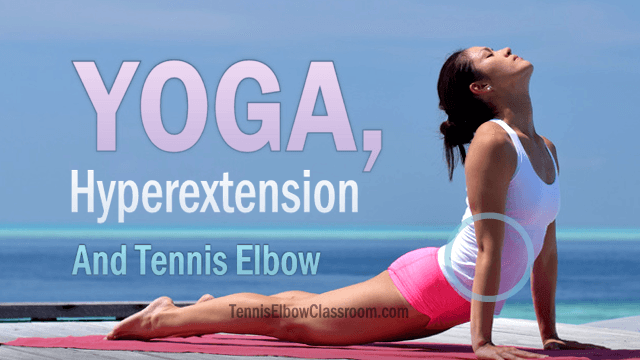
Is it a good idea to continue practicing Yoga while you’re recovering from Tennis Elbow? And are there any poses that could exacerbate or even cause Tennis (or Golfer’s Elbow) if done incorrectly?
I was motivated to write this article by a question from a Tennis Elbow Classroom Member on the advisability of certain Yoga poses while still in the process of recovering from Tennis Elbow.
Your needs may vary, but my main concern is for those of you who have a tendency toward elbow hypermobility (whether you have Tennis Elbow or not – But especially if you do!)
Does your elbow tend to extend further than 180 degrees (into ‘Hyperextension’) in the following Yoga poses – and in the images below?
If you have this tendency (which comes from an inherent, often hereditary Ligament Laxity – or “looseness”) it’s possible to damage your elbow joint by overstretching already lax ligaments.
Unfortunately, this tends to happen cumulatively – sneaking up on you gradually with minimal symptoms to warn you in the early stages.
Don’t Hyperextend Your Elbow In These Poses – Especially If You Have Tennis Elbow!
Be mindful not to Hyperextend your elbow when in these upper-body, weight-bearing poses:
(The elbow position of the woman in Cobra Pose above is OK: Her Elbows are “locked out” but not actually hyperextended.)
- Downward Dog Pose
- Reverse Plank Position
- Cobra Pose
- Camel ‘Ustrasna’
- Side Plank
- Wheel Pose

Elbow Hyperextension in the Downward Dog Pose
In the image above, you can clearly see that the elbows of the woman in Downward Dog Pose, have gone beyond 180 degrees and into hyperextension. (More examples below.)
Yoga Teacher Diane Bruni has written the most comprehensive and scientific article I’ve seen so far on the subject of ‘Hypermobility’ – especially as it relates to Yoga.
Diane warns us that hypermobile people are more likely to injure themselves:
“Many famous yoga teachers are hypermobile, … However, people who are hypermobile are more likely to injure themselves, and their injuries are slower to heal because their collagen fibers are weak to begin with.”
Diane Bruni, Yoga Teacher / Yoga studio 80 Gladstone, owner
Read her excellent article on Hyermobility here
Ligament Laxity And Joint Damage Risks In Yoga

Avoid Elbow Hyperextension in the Reverse Plank Pose
In the video below, Michaelle Edwards, creator of the YogAlign Method, discusses the dangers of ‘Ligament Laxity’ compounded by Hyperextension in certain Yoga poses, like Downward Dog.
She reminds us that the joints of the pelvis, (the hip joints especially) are weight-bearing joints, in nature, and that the shoulder is not. (I’ve always wondered about the wisdom of doing handstands and HEAD-stands, in particular!)
And that it’s not wise to stretch the shoulder that far (into extreme flexion) and in the process put more weight than ideal on the upper-body joints of the shoulders, elbows and wrists.
Pay particular attention to the obvious Elbow Hyperextension that her model goes into when she demonstrates the “incorrect” Downward Dog. See the 4:58 mark of the video:
Video: Wrist And Elbow Injuries And Yoga
Yoga Injuries On The Rise – Esp. For Women
In October of 2010, Dr. Michelle Carlson, an Orthopedist, published an article where she described how, over the course of several years, she had seen an increase in patients with hand or wrist pain brought on or aggravated by yoga practice.
“I recall one day last year when four women in a row came to see me with hand injuries they sustained while doing yoga. Four women in one day!”
– Michelle Carlson,Orthopedic Surgeon, Hospital for Special Surgery
Yoga Injuries On The Rise In Women – SheKnows.com
One of the biggest risks appears to be for women with hypermobile hip joints, who do a lot of Yoga.
This was brought into the mainstream in significant part by William J Broad, a science journalist and senior writer at The NY Times in his book, The Science of Yoga: The Risks and the Rewards in 2012, which examined:
“…centuries of history and research to scrutinize the claims made about yoga for health, fitness, emotional wellbeing, sex, weight loss…”
About a year later, Brood wrote an article in the NY Times, Women’s Flexibility Is a Liability (in Yoga)
He related how a Yoga Teacher / Author in Hawaii, Michaelle Edwards, of YogAlign – (see video on wrist and elbow injuries, above) contacted him about a little-known hip injury risk to women.
Up to this point, Yoga-related injuries in men were apparently more visible – resulting in more serious acute injuries like fractures and dislocations and subsequent trips to the E.R.
This led Brood to reach out to Orthopedic Surgeons and he discovered:
“To my astonishment, some of the nation’s top surgeons declared the trouble to be real — so real that hundreds of women who did yoga were showing up in their offices with unbearable pain and undergoing costly operations to mend or even replace their hips.”

Avoid Hyperextending your Elbow in the Cobra Yoga pose if you have Tennis Elbow.
Back to the elbow issue, according to Yoga Teacher Shannon Wianecki:
“Hyperextension of joints is chronic in the yoga world. It is common to see models and even teachers demonstrate a beautiful ustrasana (camel pose)—with backward elbows.”
“In weight-bearing poses… pay attention to your elbows.”
– Shannon Wianecki, Yoga Teacher; SpiritualityHealth.com
Yoga Dos and Don’ts: Elbow Alert
In her article she reveals the fact that she was already in chronic pain in her wrists when she began practicing due to her “distorted” elbows, and how her Yoga Teacher pointed this out to her in one of her first classes.
And she states emphatically that to overload your joints this way by taking them to their extreme end range of motion is “a recipe for injury” because of the potential wear and tear on the cartilage.
(Cartilage is the spongy tissue that cushions the inside of a joint – where the two ends of bone meet. It does not heal / regenerate – and when it wears out in the major joints people are often forced to either live in chronic pain or have joint-replacement surgery.)
In the video below, Yoga teacher, Kino, demonstrates how to avoid Hyperextending your elbow: (The audio has a lot of echo from the empty studio – but the content is solid.)
Other Poses To Be Careful In (Or Avoid) If You Have Elbow Issues
Camel Pose / ‘Ustrasna’ (Not So Risky)
Be careful to avoid Hyperextending your elbow in ‘Ustrasna’ – (Especially if you’re a Woman with Hypermobile elbow joints)
Yoga Backbends: 6 Keys to Healthy Alignment in Ustrasana (Camel Pose)
Wheel Pose (Very Risky With Tennis Elbow)
Watch your elbow alignment when you’re doing the Whee – There’s a lot of weight and pressure on your elbows and wrists in this pose:
(I would suggest avoiding this pose until your Tennis Elbow is mostly – if not fully recovered.)
Check out Common Mistakes In Wheel Pose | Yoga By Candace
Side Plank Pose (Extremely Risky)
Watch your elbow very carefully in Side Plank Pose – The weight of your entire upper body is all on one elbow and wrist in this position!
(And for this reason, I suggest avoiding this pose altogether until your Tennis Elbow is fully recovered – And being very cautious easing back into it.)
Side Plank Pose – Vasisthasana Tips | Ekhartyoga.com
Is this an absolute, “use extreme caution!” NEVER-ever-do-it rule, however?… Well, apparently, not necessarily!
In the following article the author gives us a very nuanced, thoughtful alternative view, calling into question the idea that hyperextension is always wrong.
And reminds us of the principle that a certain about of stress/load on the body (tension and compression) is healthy and necessary to build or maintain strength and health overall.
If you want to get more technical, (I loved it!) you’ll get a better sense of the differences between:
- Hyperextension in the Medical sense (an indication of damage)
- Hyperextension in the theoretical, anatomical sense (the elbow joint “normally” extends to 180 degrees, so beyond that it is technically Hyperextended)
- And the concept of ‘Locking Out’ a joint (which may or may not put that joint into hyperextension – depending on an individual’s joint structure / ligaments.)
If you can see the image below, the woman is extending her elbow past 180 degrees (which is considered “normal” full extension) to an extreme, 195 degrees.
And, underneath, the man has his elbow at about 20 degrees short of full extension.
(Possibly intentionally, just for demonstration purposes, but quite possibly, because he can’t reach full extension due to muscular tension in his Biceps, Brachialis and/or other elbow flexors.)
Once again, my biggest concern is for those of you with Tennis Elbow who are also Yoga enthusiasts.
I’m not saying “Don’t do Yoga while you have Tennis Elbow” – You may find Yoga to be helpful in your recovery!
Or, even that you shouldn’t do any of these poses that involve weight bearing on the upper exteemity…
Just be careful, and be aware of this elbow Hyperextension risk – Especially if you’re female or you know you have outright joint Hypermobility or a tendency toward Ligament Laxity!
Learn To Treat And Heal Your Own Tennis Elbow Or Golfer’s Elbow At Home With This Video Program
You’ll get instant access to a complete VIDEO program designed by a professional therapist to help you take charge and break your vicious cycle of pain and frustration!…I’ll be your personal tutor guiding you through step-by-step video lessons, where you’ll get the therapy techniques, key stretches and essential exercises you need to treat and recover from your injury at home. (Without any special equipment.)
Tennis Elbow sufferers: learn more and get started here
Golfer’s Elbow sufferers: learn more and get started here







I would also include Salabhasana (Locust) in this list such as the pose in this image http://www.bikramyoga.com/images/17.jpg and also certain variation of seated twist http://bikramyogacolumbia.com/wordpress/wp-content/uploads/2012/10/Rachel-Spine-Twist-5437-750×750-custom.jpg
Thanks, Wenzday. I wouldn’t worry about either of these poses, since they’re not upper-body load-bearing. Locust / Salabhasana looks like it could require some upper-extremity effort – but I think it might be fine, since the wrists stay in a neutral position and it’s more Wrist Flexor involved.
As far as the Spinal Twist goes, my only concern is the extreme internal rotation required of the shoulder. (On her Right side in the photo.) IF one happens to have instability in their Rotator Cuff (which is common in connection with Tennis Elbow, in my clinical experience.)